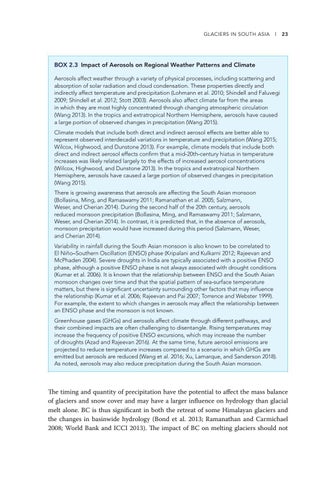Glaciers in South Asia l 23
BOX 2.3 Impact of Aerosols on Regional Weather Patterns and Climate Aerosols affect weather through a variety of physical processes, including scattering and absorption of solar radiation and cloud condensation. These properties directly and indirectly affect temperature and precipitation (Lohmann et al. 2010; Shindell and Faluvegi 2009; Shindell et al. 2012; Stott 2003). Aerosols also affect climate far from the areas in which they are most highly concentrated through changing atmospheric circulation (Wang 2013). In the tropics and extratropical Northern Hemisphere, aerosols have caused a large portion of observed changes in precipitation (Wang 2015). Climate models that include both direct and indirect aerosol effects are better able to represent observed interdecadal variations in temperature and precipitation (Wang 2015; Wilcox, Highwood, and Dunstone 2013). For example, climate models that include both direct and indirect aerosol effects confirm that a mid-20th-century hiatus in temperature increases was likely related largely to the effects of increased aerosol concentrations (Wilcox, Highwood, and Dunstone 2013). In the tropics and extratropical Northern Hemisphere, aerosols have caused a large portion of observed changes in precipitation (Wang 2015). There is growing awareness that aerosols are affecting the South Asian monsoon (Bollasina, Ming, and Ramaswamy 2011; Ramanathan et al. 2005; Salzmann, Weser, and Cherian 2014). During the second half of the 20th century, aerosols reduced monsoon precipitation (Bollasina, Ming, and Ramaswamy 2011; Salzmann, Weser, and Cherian 2014). In contrast, it is predicted that, in the absence of aerosols, monsoon precipitation would have increased during this period (Salzmann, Weser, and Cherian 2014). Variability in rainfall during the South Asian monsoon is also known to be correlated to El Niño–Southern Oscillation (ENSO) phase (Kripalani and Kulkarni 2012; Rajeevan and McPhaden 2004). Severe droughts in India are typically associated with a positive ENSO phase, although a positive ENSO phase is not always associated with drought conditions (Kumar et al. 2006). It is known that the relationship between ENSO and the South Asian monsoon changes over time and that the spatial pattern of sea-surface temperature matters, but there is significant uncertainty surrounding other factors that may influence the relationship (Kumar et al. 2006; Rajeevan and Pai 2007; Torrence and Webster 1999). For example, the extent to which changes in aerosols may affect the relationship between an ENSO phase and the monsoon is not known. Greenhouse gases (GHGs) and aerosols affect climate through different pathways, and their combined impacts are often challenging to disentangle. Rising temperatures may increase the frequency of positive ENSO excursions, which may increase the number of droughts (Azad and Rajeevan 2016). At the same time, future aerosol emissions are projected to reduce temperature increases compared to a scenario in which GHGs are emitted but aerosols are reduced (Wang et al. 2016; Xu, Lamarque, and Sanderson 2018). As noted, aerosols may also reduce precipitation during the South Asian monsoon.
The timing and quantity of precipitation have the potential to affect the mass balance of glaciers and snow cover and may have a larger influence on hydrology than glacial melt alone. BC is thus significant in both the retreat of some Himalayan glaciers and the changes in basinwide hydrology (Bond et al. 2013; Ramanathan and Carmichael 2008; World Bank and ICCI 2013). The impact of BC on melting glaciers should not




